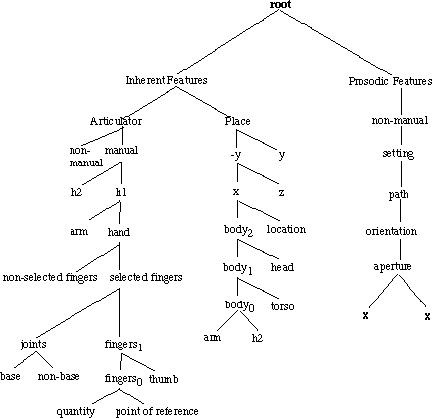I have not gone crazy. Well, perhapsI have, but I am certain that after reading this post you will understand.
This week I am really lucky to be able to attend the first summer school in Linguistics in Buenos Aires (ELBA), organised by a group of young linguists from the University of Buenos Aires. One of the courses has truly fascinated me, and it is on the linguistics of Sign Language. Today we discussed the Phonology of Sign Language, and yes, this is exactly what this post will be about. I will be discussing a few issues that were presented on the lesson, and also refer you to a few reading materials and links I have found interesting.
***
The course I am taking is "Current Issues in Sign Language Linguistics", and it is led by Josep Quer, from ICREA & Universitat Pompeu Fabra, Barcelona. Among the interesting things I suspected regarding Sign Language (SL) before this course, and which I can now confirm, I could mention that SLs are not "pantomime systems", they are not generally based on the spoken languages in their communities, they are neither sign systems nor manual alphabets (which are just secondary representations of language), and they have really complex (and interesting!) structures, which are even open to sociolinguistic variation. Fascinating.
Now to Sign Language Phonology. The study of SL Phon started in the 60s with William Stockoe. He found that in SL there are three categories (or parameters) that can bring about differences in meaning and are combined according to language specific-constraints (thus leading to the creation of minimal pairs): handshapes, locations (or place of articulation) and movements. Each "phoneme", in fact, each segment, has got an internal structure made up of at least one handshape, one orientation (direction), and one location . Optionally, it may present movement (sometimes repeated), and non-manual components. The simultaneous and sequential combination of these parameters makes up the usually monosyllabic signs. (BTW, you can see some minimal pairs here)
The articulators that signers use include hands (dominant, and non-dominant) and arms, but also the head and trunk with their parts. Signs can be one-handed, or two-handed. Two-handed gestures are constrained by the conditions of symmetry and dominance (Sandler, 2002, clearly explained here). There may be mouthings (derived from spoken language), and also mouth gestures.
The features making up handshakes include the description of which and how many fingers are active, and whether these are "straight, bent, flat or curved" (Brentari, 2012), that is, the selection, quantity and joints of the fingers. The features within place of articulation or location are connected to where in the body the signs are placed (head, arm, torso, cheeks, eyebrows, etc), and the plane (horizontal, vertical, midsagittal). The features of movement include orientation (towards the speaker or interlocutor with the wrist or forearm), path (displacement of hand in space), setting (high, low, ipsi, contra, distal, contact), aperture of finger joints. The status of transitional movements between signs is a problematic issue, as is the establishment of what features could be deemed linguistic and which, paralinguistic, in some circumstances.
 |
| Brentari's model. Credit: http://www.sign-lang.uni-hamburg.de/intersign/workshop2/brentari/brentarim.gif |
Beyond the segment, we learned that a syllable in SL is made up of the combination of a location + movement + location. Sentence accent and intonation in connection to foreground and background information can be marked with a change in the dominant hand (keeping the background information with the non-dominant hand, or H2 and moving on with the dominant one!), and specific intonational meanings can be expressed with facial expressions. Non-manual gestures with the use of eyebrows or the lips, for example, however, may also be part of specific signs. Changes in "volume" may be effected through the use of wider or narrower, bigger or smaller signs, which could resemble shouting or whispering qualities in spoken languages. The combination of signs, and even processes of compounding, exhibit very interesting cases of assimilation and deletion! (Some examples of some of these issues here)
Sign Language Phonology appears to be a fascinating field, and I hope you have found it as appealing as I have!
***
A few references recommended by Prof. Quer:
- Sandler, W. & D. Lillo-Martin. 2001. Natural Sign Languages. In The Handbook of Linguistics, eds. M. Aronoff & J. Rees-Miller, 533-562. Oxford: Blackwell.
- Brentari, D.. 2012. Phonology. In Sign Languages (Handbooks of Linguistics and Communication Science, HSK), eds. R. Pfau, M. Steinbach & B. Woll, 21-54. Berlin: Mouton de Gruyter.
A few links I have found interesting:
- Dictionary of Argentine Sign Language: http://manosquehablan.com.ar/
- Lengua de Señas Argentina: http://lsa-argentina.blogspot.com.ar/
- Sandler, W. The Grammar of the Body: http://signlab.haifa.ac.il/index.php/2013-01-15-06-56-20 (Also visit the "People" tab to read some of Sandler's publications on Phonology)
- University of Chicago's Sign Language Lab Publications: http://signlanguagelab.uchicago.edu/page/publications
Enjoy! (In American Sign Language - Font downloadable from here)

